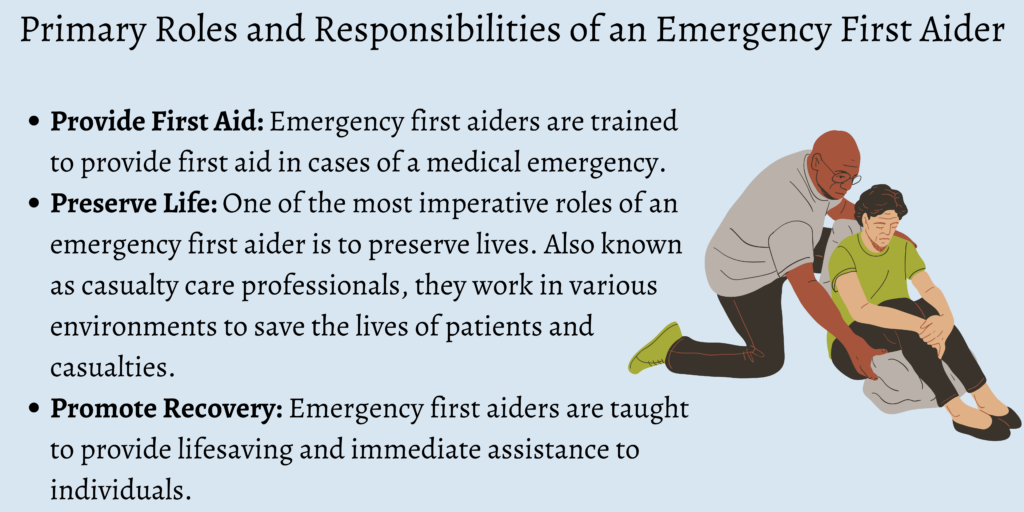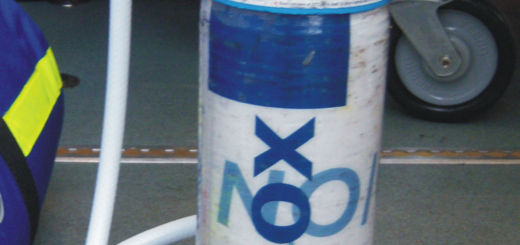The Role and Responsibilities of an Emergency First Aider
Several countries worldwide have emergency first aiders, especially in a workplace setting, since companies must ensure that there is always someone to keep the employees safe in cases of sudden illnesses or accidents. Whenever a person gets injured, they can be taken to the emergency room for the help and treatment they need. However, that can often take a long time, and that’s where emergency first aiders come in.
Who is an Emergency First Aider?
An emergency first aider is a professional who provides emergency first aid facilities to protect the lives of those experiencing any illness or injury.
They ensure that the situation doesn’t worsen for the patient, no matter what they are facing, while waiting for the emergency medical services to arrive at the given location.
Emergency first aiders take on the task of recognizing and diagnosing illnesses and injuries while also administering emergency treatment.
What are the Primary Roles and Responsibilities of an Emergency First Aider?
The training given to an emergency first aider equips them to respond to emergencies quickly. They help with the major injuries caused by accidents as well as with minor injuries such as bruises and cuts. Some can also provide help with severe cases like strokes and heart attacks.
The major roles of an emergency first aider are as follows:
Provide First Aid
Emergency first aiders are trained to provide first aid in cases of a medical emergency. Several organizations offer emergency first aid training, and the law requires that those working as independent contractors
possess this training.
A patient who has experienced a cardiac arrest or stopped breathing can receive CPR from an emergency first aider. They provide care for the casualties who have been burned, cut, or injured and conduct safety checks for those who have come in contact with harmful chemicals.
Preserve Life
One of the most imperative roles of an emergency first aider is to preserve lives. Also known as casualty care professionals, they work in various environments to save the lives of patients and casualties.
They ensure the victim is breathing and help keep their heartbeat going until medical help arrives. If, in the unlikely event, they need to revive someone whose heart has stopped beating, they are trained to use an AED on them.
After stabilizing the patient, they go through a checklist before calling for medical help. That includes checking for any signs of infection, ensuring the patient’s airway is clear so they can breathe properly, and ensuring there’s someone around to help the casualty once they reach the hospital.
Promote Recovery
Emergency first aiders are taught to provide lifesaving and immediate assistance to individuals. Whether a patient is facing breathing issues, is choking, or has passed out due to a lack of blood flow, an emergency first aider can help with all these situations.
Promoting a patient’s recovery process ensures that the victim doesn’t currently have any life-threatening injuries and that they are prepared to respond immediately if the situation changes.
To accelerate the recovery process, an emergency first aider assesses a patient’s condition and stabilizes them before moving on to the next step in their treatment. They ensure the scene is free from hazards like electrical dangers and toxic materials.
Their job also includes ensuring that all the vital medical equipment is easily accessible and that they adhere to the medical protocol to treat all sorts of cases, including children and senior citizens.
The role of a first aider is to provide immediate, lifesaving, medical care before the arrival of further medical help could include performing procedures such as:
- Placing an unconscious casualty into the recovery position
- Performing Cardiopulmonary resuscitation (CPR)
- Using an automated external defibrillator (AED)
- Stopping bleeding using pressure and elevation
- Keeping a fractured limb still
A first aider’s overall aim should be to preserve life. Other aims of first aid include prevent the worsening of the patient’s condition and to promote recovery. Take a look at our article on the aims of first aid for more information.
A first aider has various responsibilities when dealing with an emergency situation. A first aider should:
- Manage the incident and ensure the continuing safety of themselves, bystanders and the casualty
- Assess casualties and find out the nature & cause of their injuries
- Arrange for further medical help or other emergency services to attend (the fire service)
- If trained, prioritize casualties based upon medical need
- Provide appropriate first aid treatment as trained
- If able, make notes/observations of casualties
- Fill out any paperwork as required
- Provide a handover when further medical help arrives
Some of the other responsibilities of an emergency first aider include:
- Placing an unconscious patient into the recovery position.
- Making use of pressure and elevation to stop the bleeding.
- Keeping a victim’s fractured limb still.
- Fill out any necessary paperwork following the accident or incident.
- Staying calm under stressful conditions, reassuring the casualties, and taking charge of the situation.
What is the Importance of First Aid?
The following are the reasons why first aid is important:
- First aid prevents an injury from getting worse. When a person is given proper first aid, the extent of damage gets contained and they have a much better chance of survival.
- The recovery of a victim happens at a much quicker pace with first aid. In some situations, a person doesn’t even require further or deeper medical care if first aid is provided on time. This is applicable in case of minor injuries such as bruises and cuts.
- First aid helps in providing pain relief and keeps the pain of a victim under control. A person who is trained in first aid knows how to look after a victim who is distressed regardless of the nature of their injury.
- There are certain scenarios where a victim is unconscious, and providing the necessary first aid to such victims keeps them protected till the arrival of medical help.
- The lives of many people are saved through competent and quick first aid. Certain health emergencies could be the difference between life and death, and it’s through first aid that many people get to live and avail further treatment.
Qualities of a Good First Aider
In order to be a good first aider, you need to have the following qualities:
- Empathy and selflessness: A first aider needs to be empathetic and selfless. When you see someone in a medical crisis in the middle of the road, for instance, it’s easy to think that someone else will help them. However, putting yourself in the shoes of the patient enables a first aider to determine the next best step. Selflessness is what enables first aiders to help a victim and worry about the patient’s well-being before thinking of their own mortality.
- Prompt and communicative: Providing first aid requires a person to be quick and prompt with their actions. A first aider needs to think quickly and immediately assist the victim in question. Being communicative is one of the prime qualities for a first aider, as it’s through communication that they can understand what a patient needs and how to convey it to the emergency medical services.
- Vigilance: A first aider needs to assess the situation and surroundings quickly whenever they come across a victim. This is why they need to be vigilant so as to keep the victim protected till the medical services reach the scene.
- Fitness: Emergencies can occur in any setting, which is why being physically fit enables you to help a person even if they’re in a remote or awkward location.
- Positivity and calmness: Staying calm in the face of adversities is imperative for a first aider so that they can take the necessary actions to help a victim. They must also stay positive so they can reassure the victim and let them know that everything will be fine.
What are the Different Types of First Aid?
Listed below are the different types of first aid:
- Cardiopulmonary resuscitation or CPR
- Bleeding
- Choking
- Burns
- Broken bones
- Frostbite
- Sprains
- Blisters
- Heatstroke
- Nosebleed
How Do I Become a First Aider?
Here is how you can become a first aider:
- Choose the right level of first-aid training.
- You can enroll for a one-day emergency first aid at work (EFAW) course or a three-day course of first aid at work (FAW).
- Pass the Regulated Qualifications Framework (RQF) exam, after which you will be given a Regulated Qualifications Framework (RQF) certificate and ID.
- Every first aider needs to go for an annual fresher training so as to stay updated about the latest changes in the field.
FAQs
What are some of the most common medical emergencies?
Some of the most common medical emergencies are strokes, seizures, and heart attacks.
What is the aim of first aid?
A couple of the aims of first aid are to preserve life, aid recovery, relieve pain, and protect unconscious victims.
Who is the founder of modern first aid?
Friedrich Esmarch.
What does ABC mean in first aid?
The ABC in first aid means airway, breathing, and circulation.
Conclusion
An emergency first aider has training in first aid, defibrillation, and CPR. They know how to use medical equipment in cases of emergencies, such as an automated external defibrillator (AED), and have the skills necessary to work alone till the patient is taken to the hospital or until a paramedic gets to the scene.
Every emergency first aider should know how to assess the situation, decide the best course of action and implement it, and assist the patients and casualties.
Being an emergency first aider allows you to save many lives, making this career and the training that goes with it extremely important.







I’d argue another role of a first aid provider would to be assume a position of leadership in an emergency. If a disaster strikes, and you’re the only one with training around, you’re going to have to overcome the Bystander Effect, and guide those you around into helping you — particularly if there a lot of people hurt. Being a calm, authoritative presence in the midst of a problem can really do a lot to calm a panicked situation, and in a disaster you need as many clear heads as you can get!
I agree with you moonmoon, and I feel there would be a distinction between delegations vs. leadership. Because even though the person may be the only one competent enough to assess the situation and bypass the Bystander Effect, if they can’t have enough humility to know more people to help can help in sustaining the life of an individual, it sort of defeats the purpose of the role of a first aider.
It can be scary whenever one is in a situation like that, and it’s even scarier whenever it actually happens to the individual that needs to be saved! I remember falling down and lapsing in consciousness for a few seconds due to dehydration and having inadequate amount of sleep. I was fortunate to have the assistant coach at the time to aid me, and I realized that most people just looked at me falling victim to the Bystander Effect. I guess it’s really true that people either have no conscience in a person falling down like that, or they just don’t know how to handle the situation.
Anything could happen no matter what, where, who, or, even how the situation so yes I can say I agree with moonmoon as well….
I agree because it is important to be prepared because something could always happen and you could help if you acted fast and knew what to do.
We agree!
Another thing to add to this would be always stay with the casualty and do not abandon the casualty as it would worsen the situation.
im going to say yes as its something you need it could happen too whoever and where ever
This is very informative. I do agree.